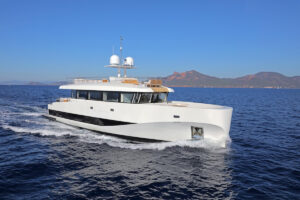
The record-setting long-distance sailor Reid Stowe, a self-described “shaman mystic” who once roamed the planet under sail for 1,152 days without stopping or setting foot ashore, is a one-of-a-kind mariner. My first encounter with Reid was some two decades ago, when I was writing a weekly boating column for The New York Times. I was dispatched to Pier 63 in Manhattan to interview the artist, sculptor and voyager. Fit, lean and handsome, he had quite the story to tell.
At the time, Reid was living aboard his 70-foot schooner, Anne, which he’d built in the early 1970s on a North Carolina beach with a crew of like-minded acolytes. He’d named the boat after his mother and had just completed a 200-day trip, which he dubbed “The Voyage of the Sea Turtle” after the image of a giant terrapin he’d carved in the seas with his wake via the trip’s GPS track. Prior to that, he’d sailed Anne to Antarctica, and on that expedition he’d come up with the idea of a 1,000-day marathon at sea. This one also had a handle: “The Mars Ocean Odyssey.” It turned out to be the hook for my Times piece.
Why Mars? Simple. Reid surmised that a three-year, unsupported, nonstop “space analogous” voyage—a marathon sail so unique that the only thing he could compare it to was a passage through the heavens—would take as long as a flight to Mars and pose similar psychological challenges. During the round-the-world passage that he completed between 2007 and 2010, that turned out to be the case.
In the aftermath of the journey, a funny thing happened: Elon Musk launched SpaceX and floated the idea of launching a rocket ship to Mars. That got Reid’s wheels turning once again. Who would be the ideal person to command such a spaceship, to lead such an audacious human undertaking? He believed that he would.
Read More from Herb McCormick: And The US Sailing Capital Is?
I learned this last fall on my most recent visit with Reid, this time in his spacious studio on Manhattan’s West Side. (He still owns Anne, which is currently anchored across the Hudson River in a New Jersey backwater.) Though he’s now 71, still dashing but no longer youthful, he nonetheless made a pretty eloquent case for his “Rocket Man” ambitions: “At sea, you’re constantly looking up at the stars, which are also reflected in the water below. The sensation is almost exactly like a spaceman venturing through the stars. For humanity to evolve off this planet to become a multiplanetary species, this is such an important moment in history. And Musk is developing the rocket that will take humans to Mars. We will be living among the stars. If we’re going to do it, we’ll need the right people.”
Reid reckons that trained astronauts may have certain necessary technical skills, but they would lack the understanding of true isolation that he’s experienced as a sailor.
Reid has been longing to get Musk’s attention, to date to no avail. Before returning to New York, he even sailed Anne across the Gulf of Mexico to the Texas coast with a crew of would-be astronaut trainees to catch a SpaceX satellite launch. He has, however, attracted the interest of the greater Mars space community—and a former NASA engineer has volunteered to build him a Mars-ready spacesuit. He has a life-size rendering of it on a canvas adorning one of his studio walls.
It’s fairly impossible what to make of all of this, but as I bid farewell to Reid, I was reminded never to bet against him, as I might’ve in the past. Yes, he’s a bit spacey (no pun intended) and certainly eccentric. But his track record is a proven one.









